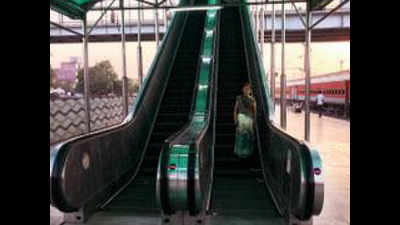- News
- City News
- lucknow News
- Development to blur caste in Ghazipur?
Trending
This story is from May 18, 2019
Development to blur caste in Ghazipur?
The swanky escalator on platform number 1 of Ghazipur railway station is no less than a robotic feat for people in this laidback UP district that shares borders with Bihar.

The craze for escalator has become a problem for railway officials, who are forced to switch it off
GHAZIPUR: The swanky escalator on platform number 1 of Ghazipur railway station is no less than a robotic feat for people in this laidback UP district that shares borders with Bihar.
Children and elders buy a platform ticket only to go up and down on the escalator. However, their craze has become a problem for railway officials, who are forced to switch it off.
“The escalator is meant for passengers… it’s not a joyride… but locals are excited because they are seeing it for the first time,” said a station employee.
Some people talk about Sinha’s claim of bringing development to Ghazipur, but many feel that vikas was still a distant dream. “For more than six months each year, one-fourth of Ghazipur turns into an island as the bridge over the river Ganga connecting district headquarter to Tarighat is yet to be completed,” said Suraj Gupta, a clerk.
But a short drive into the interior takes one into an India of 1970s, where caste is at the core of all conversations. “Caste dominates everything in UP and Bihar… Ghazipur is a classic lab of caste maths,” said MC Lal.
Children and elders buy a platform ticket only to go up and down on the escalator. However, their craze has become a problem for railway officials, who are forced to switch it off.
“The escalator is meant for passengers… it’s not a joyride… but locals are excited because they are seeing it for the first time,” said a station employee.
Some people talk about Sinha’s claim of bringing development to Ghazipur, but many feel that vikas was still a distant dream. “For more than six months each year, one-fourth of Ghazipur turns into an island as the bridge over the river Ganga connecting district headquarter to Tarighat is yet to be completed,” said Suraj Gupta, a clerk.
Unemployment is also a key poll issue. While tea stalls debate over two crore jobs, they feel that the double engine (the duo of PM Narendra Modi and Sinha) could do nothing to start the Bhadarua Cotton and Nandganj Sugar mills.
But a short drive into the interior takes one into an India of 1970s, where caste is at the core of all conversations. “Caste dominates everything in UP and Bihar… Ghazipur is a classic lab of caste maths,” said MC Lal.
End of Article
FOLLOW US ON SOCIAL MEDIA











